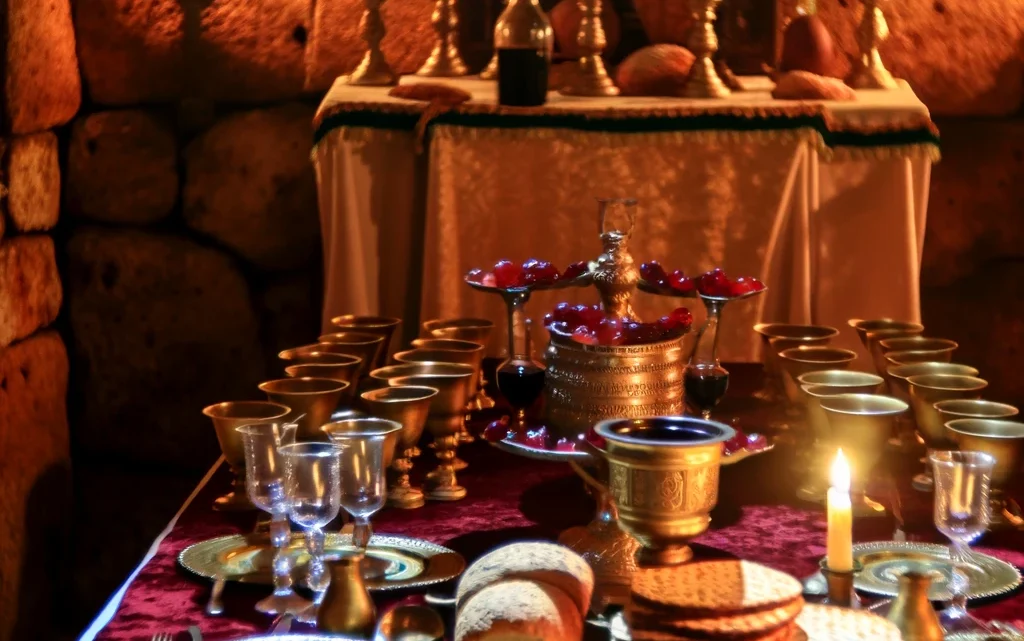“Echoes of Antiquity: Unveiling the Hebrew Roots of Yeshua’s Prayers from Passover to the Last Supper”


The liturgical practices observed by Yeshua (Jesus) during His lifetime, particularly those involving prayers over bread and wine, provide a fascinating insight into the confluence of Jewish tradition and early Christian rites. These practices are not merely religious formalities but are deeply rooted in the Jewish liturgical landscape of the first century, blending seamlessly with the profound theological innovations introduced by Yeshua, especially during the Last Supper.
#### The Jewish Liturgical Foundation
Jewish prayer life in the first century was characterized by an established set of blessings and rituals, many of which had been orally transmitted and later codified in Jewish religious texts like the Mishnah. These blessings typically recognized God’s providence and expressed gratitude for His gifts, including food and festive occasions.
**Hamotzi and Borei P’ri HaGafen**: The traditional Jewish blessings over bread (“Hamotzi”) and wine (“Borei P’ri HaGafen”) are prime examples. The prayers for bread and wine are as follows:
– **Bread (Hamotzi)**:
– **Hebrew**: בָּרוּךְ אַתָּה יְהוָה אֱלֹהֵינוּ מֶלֶךְ הָעוֹלָם, הַמּוֹצִיא לֶחֶם מִן הָאָרֶץ.
– **Transliteration**: Baruch atah Yehovah Eloheinu, Melech ha’olam, hamotzi lechem min ha’aretz.
– **Translation**: Blessed are You, Yehovah our God, King of the Universe, who brings forth bread from the earth.
– **Wine (Borei P’ri HaGafen)**:
– **Hebrew**: בָּרוּךְ אַתָּה יְהוָה אֱלֹהֵינוּ מֶלֶךְ הָעוֹלָם, בּוֹרֵא פְּרִי הַגָּפֶן.
– **Transliteration**: Baruch atah Yehovah Eloheinu, Melech ha’olam, borei p’ri hagafen.
– **Translation**: Blessed are You, Yehovah our God, King of the Universe, who creates the fruit of the vine.
#### Passover Seder: A Detailed Ritual
During Passover, Yeshua’s prayers would have included elements specific to the Seder. This includes the recitation of the Hallel Psalms (Psalms 113-118), which celebrate deliverance from Egypt. The Mishnah (Pesachim 10) details these Seder practices, including the order of the meal and the blessings recited.
#### Pharisaic Influence on Liturgical Prayers
The Pharisees, instrumental in shaping Jewish liturgy during this era, helped ensure that prayers and rituals were meticulously preserved and practiced. This background shaped the prayers Yeshua used during religious observances, blending traditional Jewish piety with His unique message of redemption.
#### The Last Supper: A New Covenant
The Last Supper stands out as a pivotal moment where Yeshua infused traditional Jewish prayers with new significance. By describing the bread as His body and the wine as His blood of the covenant, He transformed the Passover meal into a profound commemoration of His death and resurrection, laying the foundation for the Christian Eucharist or Communion practices.
### Conclusion
The prayers of Yeshua at the Last Supper are a beautiful testament to the continuity and transformation within religious practices. They demonstrate how Yeshua both respected and transcended His Jewish heritage, establishing a new covenant that would resonate through the ages in Christian worship. This blending of tradition and innovation is a powerful reminder of the deep historical roots of Christian liturgical practices, firmly anchored in the rich soil of ancient Judaism. By exploring these ancient texts and traditions, both Jewish and Christian communities can appreciate the shared historical and spiritual heritage that shapes their faith practices today.

